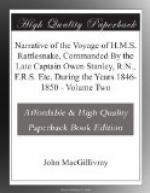It would be curious to see the effects produced at the point of junction of these two sections of the same race, probably somewhere between Aird River and Cape Possession. It is not unlikely that the Papuans of Redscar Bay and its vicinity derived the use of the bow and arrow from their neighbours to the westward—and that the kind of canoe in use in Torres Strait was an introduction from the eastward, is rendered probable—setting aside other considerations—by a circumstance suggested by the vocabularies, i.e. that the name for the most characteristic part of the canoe in question—the outrigger float—is essentially the same from the Louisiade to Cape York.*
(Footnote.
Louisiade: Sama.
Darnley Island: Charima.
Dufaure Island: Sarima.
Prince of Wales Islands: Sarima.
Redscar Bay: Darima.
Cape York: Charima.)
I have alluded in a preceding part of this work (Volume 1) to the circumstance that the small vocabulary obtained at the Louisiade may, along with others, throw some light upon the question: whence has Australia been peopled?
ORIGIN OF THE AUSTRALIAN RACE.
It may safely be assumed that the aborigines of the whole of Australia (exclusive of Van Diemen’s Land) have had one common origin; in physical character the natives of Cape York seem to me to differ in no material respect from those of New South Wales, South or Western Australia, or Port Essington,* and, I believe I am borne out by facts in stating that an examination of vocabularies and grammars (more or less complete) from widely remote localities, still further tends to prove the unity of the Australian tribes as a race.
(Footnote. M. Hombron (attached to D’Urville’s last expedition as surgeon and naturalist) considers—as the result of personal observation—that the aborigines of New South Wales exhibit certain points of physical difference from those of the North Coast of Australia, meaning, I suppose, by the latter, those natives seen by him at Raffles Bay and Port Essington. I may also mention that M. Hombron considers the Northern Australians to be a distinct subdivision of the Australian race, in which he also classes the inhabitants of the smaller islands of Torres Strait (as Warrior Island for instance) attributing the physical amelioration of the latter people to the fact of their possessing abundant means of subsistence afforded by the reefs among which they live, and the necessity of possessing well constructed canoes as their only means of procuring fish and dugong, stated by him to constitute the chief food of the Torres Strait islanders. Voyage au Pole Sud, etc. Zoologie tome 1 par M. Hombron pages 313, 314 et 317.)
The two places from one of which the Australian population may be supposed to have been more IMMEDIATELY derived, are Timor on the one hand and New Guinea on the other: in the former case the first settlers would probably have landed somewhere on the north-west coast, in the latter, at Cape York.




